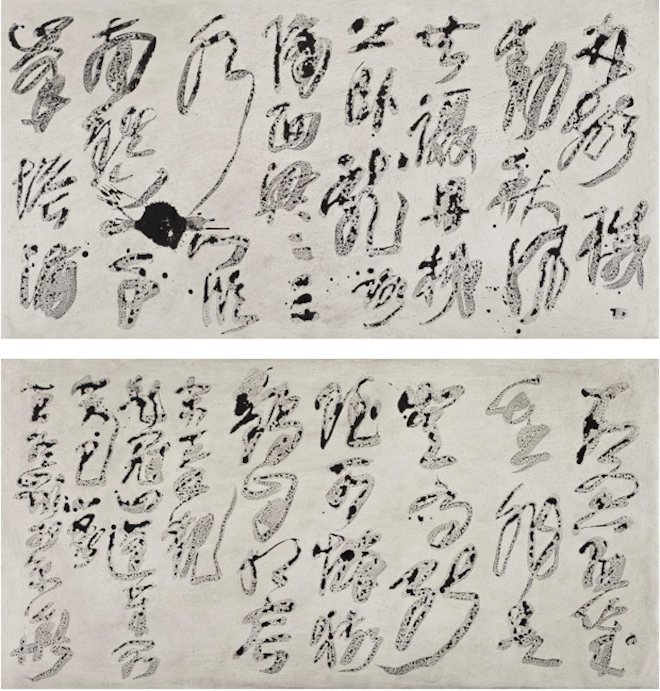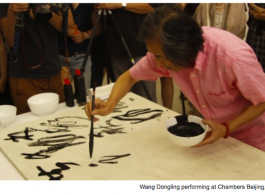Press release
Guanshan Gathering: Works by Zheng Shengtian & Wang Dongling
January 9 – February 22, 2014
Opening: Thursday, January 9, 6 – 8 pm
522 West 19th Street, New York

Zheng Shengtian & Wang Dongling,“Guanshan Gathering”,ink on canvas,set of 2, each 35 3/8 x 70 7/8 in,2013
郑胜天与王冬龄,《冠山风》,布面水墨,共2件,每件90 x 180 cm,2013
Chambers Fine Art is pleased to announce the opening on January 9, 2014 of Guanshan Gathering: Works by Zheng Shengtian and Wang Dongling. This collaboration between the influential scholar, curator and artist Zheng Shengtian and the highly regarded calligrapher Wang Donglin is the first time that they have worked together although they have formed close ties through their long-standing affiliation with the China Academy of Art in Hangzhou.
Born in 1938, Zheng graduated from the Zhejiang Academy of Art (now China Academy of Art) in 1958 and was a professor and chair of the oil painting department for over thirty years. In addition to his academic activities and energetic promotion of contemporary art from China, notably as managing editor of Yishu: Journal of Contemporary Chinese Art since 2002, Zheng has continued his own artistic practice both as a painter and in more conceptually oriented works.
Born in 1945, Wang Dongling’s studies at Nanjing Normal University were interrupted by the Cultural Revolution but he resumed his studies at the Zhejiang Academy of Art and received his MFA degree in 1981. He has been associated with this prestigious institution ever since, and is currently a professor, doctoral supervisor and Director of the China Academy of Art Modern Calligraphy Research Center.
The current collaboration between the two artists uses as model a video-installation that Zheng Shengtian contributed to the exhibition Word and Meaning: Six Contemporary Chinese Artists at SUNY Buffalo and Ohio University in 2000-2001. Using Clement Greenberg’s canonical essay “Modernist Painting” as text, Zheng made a video of his wife Aikang writing in ink on canvas accompanied by a soundtrack of the Canadian artist Hank Bull reading the essay. The four canvases were also included as part of the installation. As a result of the incompatibility of the water-based ink and the prepared surface of the canvas, the ink marks shrank until only a pattern of irregular dots remained, reminiscent of an abstract painting. The gradual deprivation of Greenberg’s words of meaning in the process of painting re-enacted the historical progress of Modernist Reductionism that Greenberg believed to be inevitable.
For Guanshan Gathering, Zheng has changed the parameters of his analysis of the relationship between mark and meaning by choosing Zong Bing’s fifth–century classic Introduction to Landscape Painting as text and a celebrated contemporary calligrapher, Wang Dongling, as executant while maintaining his detached attitude to the behavior and significance of ink as medium.
At the opening of the exhibition at Chambers Fine Art on January 9, Wang Dongling will give a public demonstration of his calligraphy in which the prepared canvases partially rebuff his highly trained gestures. The entire process will be recorded by video. Wang Dongling will also be practicing his own avant-garde calligraphy in public at the Metropolitan Museum of Art, New York, on January 11, 2014 in association with the exhibition Ink Art: Past as Present in Contemporary China.
The Guanshan Gathering of Zheng Shengtian and Wang Dongling may be seen as an erudite dialog between two well-seasoned artist/scholars, one in which Wang’s modernist calligraphy is examined by Zheng in a conceptual context that dates back to his first consideration of these issues in 2000.



